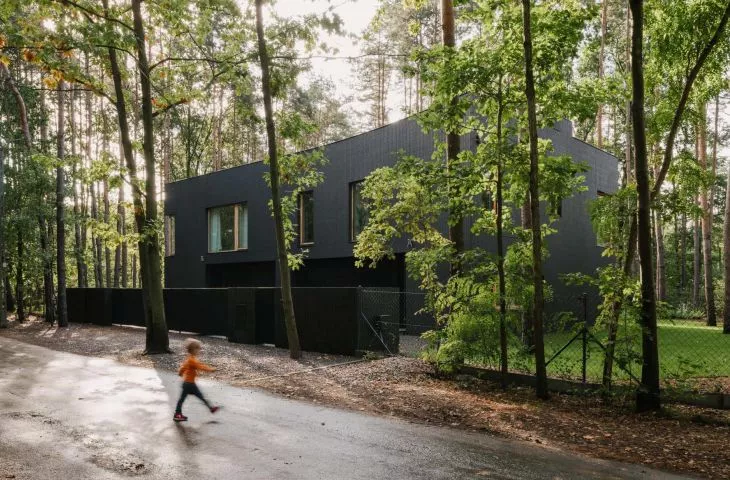A pair of architects with a love for simple, functional architecture that matches its surroundings near the picturesque Mazovian Landscape Park found a dream location to create their first home together, which, as they write, has become a unique combination of creative concept and calculation.
The house, although standing in the capital, is surrounded by a natural, green landscape. Thanks to well-thought-out and functional solutions, the residents are comfortable, and both the cost of construction and its negative impact on the environment have been reduced as much as possible.
The 


mainly natural materials were used for construction: ceramics, pine and larch wood, Polish stone
Photo: ONI Studio | Justyna Kuska, Maciek Jeżyk
Thecompact, two-story building housing two units was located on an irregular, eastward narrowing plot with twelve tops. Each half of the house, including the garages, has about 186 m² of floor space. Thanks to the placement of the entrance on the northeast side, the body of the house could be positioned in such a way as to minimize shading between the two separate living areas. The front elevation, which is close to the street, is slightly concave, so that the mass appears slender, the facade creates interesting chiaroscuro effects, and thanks to the front windows - brings the rays of the rising sun into the interior.
black facade
The dark, almost black color of the vertically arranged clinker tiles on the facade with its color and texture refers to the bark of the trees surrounding the house. Part of the front facade and garage door was finished with thermally modified pine board, which, thanks to its vertical arrangement and black painting, does not contrast with the ceramic cladding.
The 


The front elevation is slightly concave
Photo: ONI Studio | Justyna Kuska, Maciek Jeżyk
Thanks to the compact design, construction and utility costs have been reduced, thus reducing the carbon footprint. Mainly natural materials were used for construction : ceramics, pine and larch wood, Polish stone. The key to their selection was mainly environmental aspects. The dense-rib ceilings were chosen because of the reduction of concrete and steel, the production of which is associated with high greenhouse gas emissions. Gravel and mineral-epoxy water-permeable pavement, which promotes natural water retention, were used for the necessary paving of the site, the project authors write.
The dark body of the house is punctuated in places by large glazings, some of the windows are two-story high, thus providing daylight deep into the living areas and guaranteeing views of the forest. The light-colored window woodwork, which contrasts with the facade, was made of clear lacquered pine.
framing window views
Photo: ONI Studio | Justyna Kuska, Maciek Jeżyk
optimal space
The functional layout of the house is subordinated to the assumptions of optimal use of space - the vestibule, which protects against overcooling, leads to an unheated, brightly painted garage, a mezzanine hangs above the cars to increase storage space, a fragment of the living room, open to two floors, allows one to admire the crown of the trees surrounding the house, and athe narrow corridor, from which the study is accessible, is optically widened by an appropriately oriented single-run staircase, under which there are closets hidden behind mirrored doors.
The 


a fragment of the living room, open on two floors, allows to admire the surrounding trees
Photo: ONI Studio | Justyna Kuska, Maciek Jeżyk
Theliving room, kitchen and dining room form one open space, a natural extension of which is a spacious wooden terrace. The patinated surface of the wooden terrace is, as the architects emphasize, an optical continuation of the interior floor made of Polish Morawica marble.
The kitchen remains unexposed, the necessary storage space is hidden in wall-colored hanging cabinets. The black fronts of the lower kitchen cabinets and the green marble on the countertop, make it a living room piece of furniture. Most of the furnishings - the table, sofas and outdoor furniture - were designed by the residents and commissioned from friendly craftsmen. Second-hand items were largely used for the interior design. The white walls provide an appropriate backdrop for the collection of paintings, the designers add.



interior of the house
Photo: ONI Studio | Justyna Kuska, Maciek Jeżyk
Ola Kloc: What was a priority for you in this project?
Ania Pydo: First and foremost, meeting the housing needs of two families, including our family of five, on a tight, limited budget.
Ola: Is designing your own house more difficult than preparing a project for a client?
Ania: No, the decision-making process is definitely faster. This was the case for us - we have similar expectations and taste.



view from the terrace
Photo: ONI Studio | Justyna Kuska, Maciek Jeżyk
Ola: What influenced the final shape of the block?
Krzysztof Pydo: The sum of conditions. First of all, an attempt to achieve the largest possible functional residential area, with the best possible light, in a dense forest, on a plot of land with an irregular, triangle-like shape with twelve vertices. The rather restrictive provisions of the local plan were also a limitation.
Ola: When choosing construction and finishing materials, you took care of environmental issues, what eco-friendly solutions are worth paying attention to in the design of a single-family house?
Christopher: Attention should be paid to the correct orientation of the building with respect to the world sides. Large windows on the southwest side and minimized on the other sides favorably affect the energy balance of the house.
The compactness of our house allowed us to reduce our investment, operating expenses and carbon footprint.



house blended into forest landscape
Photo: ONI Studio | Justyna Kuska, Maciek Jeżyk
Ola: What was the most challenging part of this project, and what are you most satisfied with?
Ania: The challenge was to achieve comparable sunlight conditions for both dwellings. We are pleased that the body of the house, despite its volume, blends well into the forest landscape.

















































